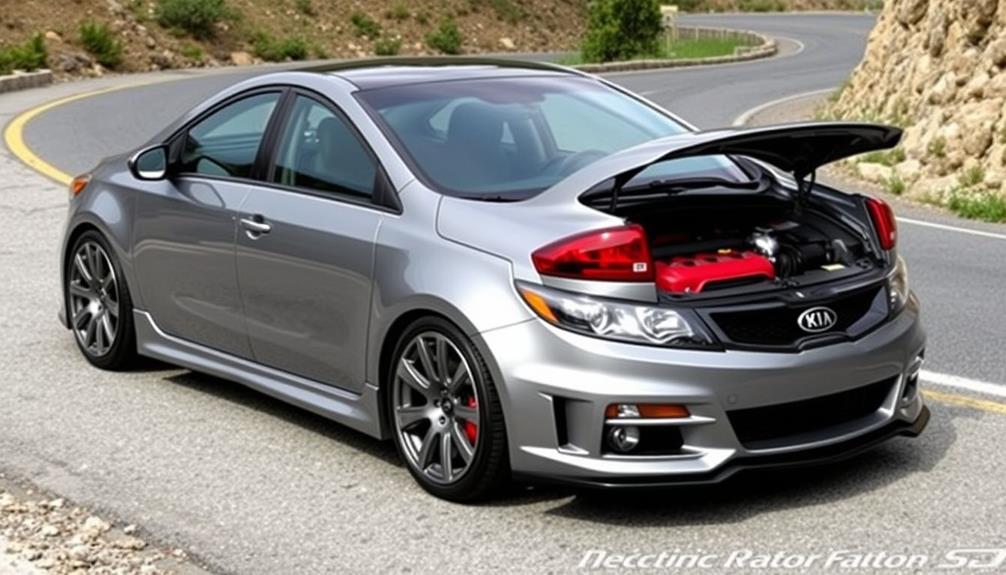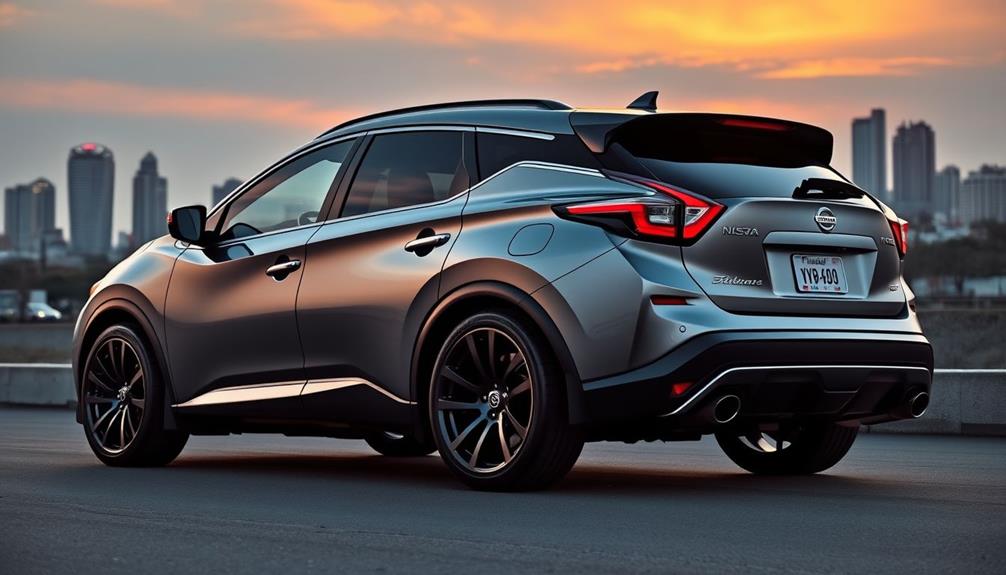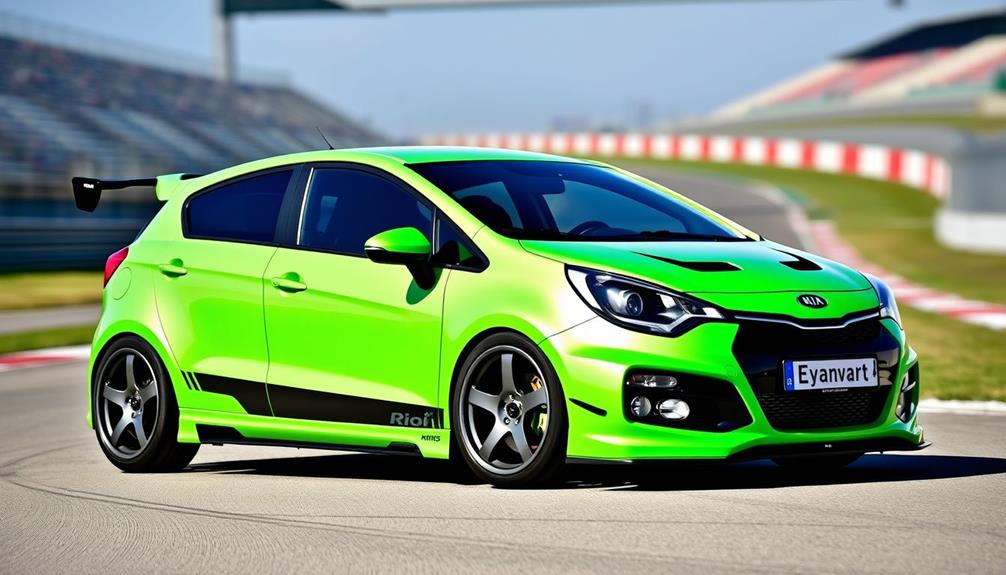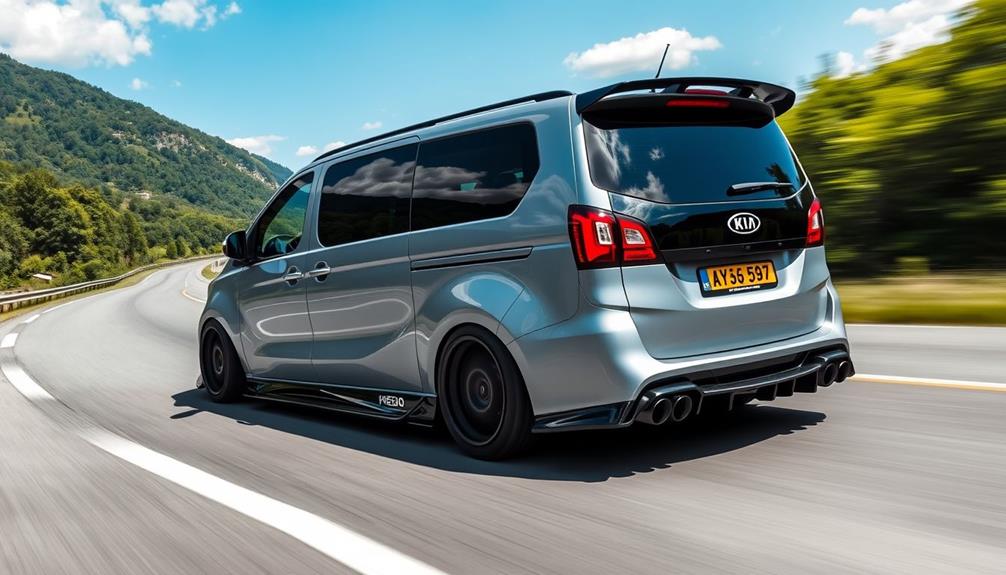Tuning your 2010 Kia Forte can greatly enhance both power and fuel efficiency. Start with basic upgrades like a cold air intake and a performance exhaust, adding up to 30 horsepower combined. If you're feeling ambitious, consider turbocharging the 2.0 engine, which can push output to around 300WHP. Installing performance chips can further refine your engine's performance and boost fuel economy by up to 4 mpg. Just remember, proper tuning and regular checks are essential to avoid engine issues. With the right techniques and insights, your Forte can achieve its full potential and provide a thrilling drive.
Key Takeaways
- Upgrade your intake and exhaust systems to gain 13-30 horsepower and improve overall engine efficiency.
- Consider turbocharging the 2.0 engine block for significant power increases, reaching up to 300WHP with proper tuning.
- Install a performance chip to enhance horsepower, torque, and potentially improve fuel economy by up to 4 mpg.
- Regularly tune your ECU post-modifications to optimize performance and ensure reliable air-fuel ratios.
- Engage with the Kia Forte community for insights on tuning practices and recommendations for reputable tuners.
Basic Power Upgrades
When it comes to enhancing your 2010 Kia Forte's performance, basic power upgrades can make a noticeable difference. One of the simplest upgrades is a cold air intake, which improves airflow to the engine and can add around 5-10 horsepower. This modification allows your engine to breathe better, leading to improved throttle response.
Next, consider installing a performance exhaust system. This upgrade reduces back pressure and can yield an additional 8-20 horsepower, considerably boosting your engine's efficiency.
When you combine a cold air intake with a performance exhaust, you'll often see a synergistic effect that maximizes horsepower gains while maintaining ideal air-fuel ratios.
However, to truly benefit from these upgrades, you need to perform an ECU tune. Proper tuning is essential to fully realize the performance enhancements and avoid potential issues like vacuum leaks, which can create a lean air-fuel mixture.
Turbocharging Considerations

When considering turbocharging your Kia Forte 2010, you can expect a significant boost in horsepower, especially with the 2.0 engine block.
However, it's essential to balance that power with proper tuning to avoid reliability issues and engine damage.
To maximize performance and safety, you'll need to focus on ideal air-fuel ratios and regular dyno testing.
Turbocharger Benefits Explained
Turbocharging offers a remarkable way to enhance the performance of your Kia Forte 2010, potentially boosting horsepower by up to 300WHP. This significant performance boost can transform your compact sedan into a thrilling driving experience.
The 2.0 engine block in your Forte is a solid candidate for turbocharging, as it's generally stronger than the 2.4 block, ensuring it can handle the increased power.
However, proper tuning is essential when you install a turbo setup. It helps manage the higher boost levels, which, if not monitored carefully, can lead to serious engine issues such as piston or bearing failure. This is why diligent tuning is vital to prevent damage while maximizing the benefits of turbocharging.
When executed correctly, a turbocharger can dramatically improve your car's acceleration, making every ride more enjoyable.
Keep in mind that while the potential for power is immense, it's equally important to maintain a balance between performance and safety. By focusing on careful tuning and management of your turbo system, you can fully enjoy the advantages without compromising your engine's integrity.
Engine Reliability Risks
Boosting your Kia Forte 2010's performance with a turbocharger comes with its share of risks, particularly regarding engine reliability. While turbocharging can markedly increase horsepower, it requires meticulous tuning to avoid detrimental engine issues. The 2.0 engine block is generally more robust than the 2.4, making it a better option for such modifications.
However, improper management of turbo setups can lead to severe problems, including piston melting or failure, especially at higher boost levels. Monitoring air-fuel ratios and boost levels is essential to maintaining engine reliability. Regular dyno testing post-turbocharging is advisable to guarantee everything runs smoothly and to catch potential issues early on.
Here's a quick overview of turbocharging considerations:
| Risk Factor | Impact on Engine Reliability |
|---|---|
| High Boost Levels | Increased risk of piston failure |
| Improper Air-Fuel Ratios | Can lead to severe engine damage |
| Lack of Monitoring | Missed signs of potential failures |
| Infrequent Testing | Undetected performance issues |
Optimal Tuning Practices
Achieving ideal tuning for your Kia Forte 2010 after a turbo installation is vital for maximizing performance and ensuring engine longevity. A properly tuned turbocharged setup can boost your horsepower considerably, with gains potentially reaching up to 300WHP.
Start by focusing on the 2.0 engine block, which is generally stronger than the 2.4 version, making it a better candidate for turbocharging.
Monitoring boost levels is essential—exceeding the recommended limits without appropriate tuning can lead to severe engine damage, including piston melting and bearing failure. To prevent these issues, invest in regular dyno testing after your turbo installation. This will help you verify any power gains and fine-tune your setup for optimal fuel efficiency and responsive acceleration.
Don't overlook the importance of proper engine management software. Adjusting the air-fuel ratio and ignition timing can greatly affect your performance.
Expected Power Gains
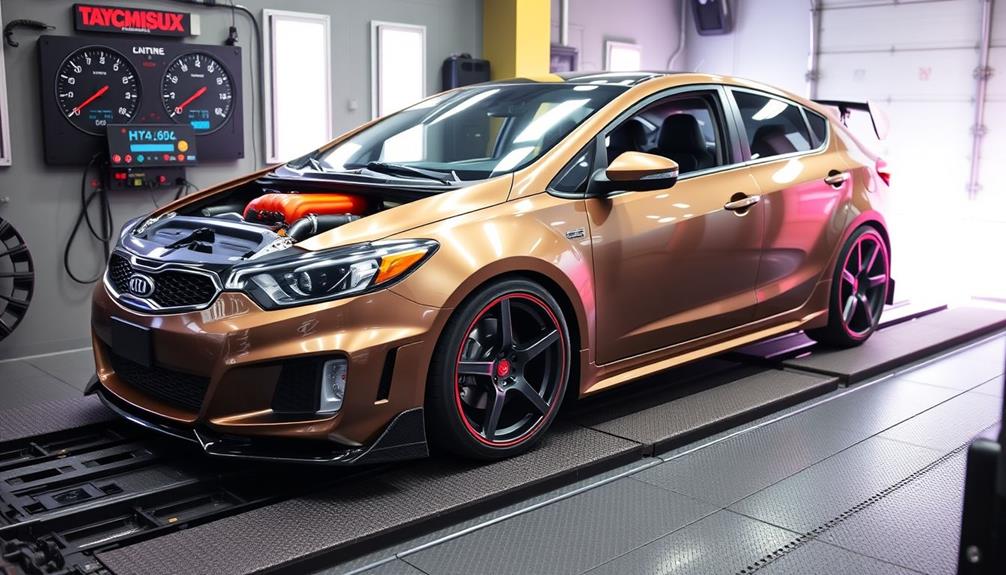
When tuning your 2010 Kia Forte, you can expect power gains that typically range from 8 to 20 horsepower with basic modifications like intake and exhaust systems.
Proper tuning is essential, as it can enhance engine output markedly, especially when considering options like a performance chip or ECU tune.
Keep in mind that without careful adjustments, you risk compromising your engine's performance and reliability.
Typical Horsepower Increases
Tuning your Kia Forte can lead to impressive horsepower gains that enhance your driving experience. With basic modifications, like upgrading your intake and exhaust systems, you can expect typical power gains of 8 to 20 horsepower, greatly boosting overall engine performance.
If you want to push those numbers further, consider a Stage 1 ECU tune, which can yield an additional 40 wheel horsepower, bringing your engine output to around 250 at the crank.
For even more substantial improvements, upgrading to a performance chip can't only increase horsepower and torque but also improve fuel economy, potentially saving you up to 4 mpg.
However, if you're feeling ambitious, turbocharging the 2.0 engine block can pump up horsepower to an impressive 300WHP. Just remember, careful tuning is essential here to avoid engine damage.
Many enthusiasts in the community emphasize that proper tuning is important for maximizing these benefits. Missteps, like vacuum leaks, can unintentionally lean out the air/fuel ratio and negatively impact your car's performance.
Importance of Proper Tuning
Maximizing your Kia Forte's performance hinges on proper tuning, which can greatly impact expected power gains. With a Stage 1 tune, you could achieve around 40 WHP, pushing your total output closer to 250 at the crank. This tuning process isn't just about power; it's about making certain your car runs efficiently with the new enhancements.
Basic modifications like a Cold Air Intake (CAI) or Short Ram Intake (SRI) can also add 5-10 horsepower each. When you combine these upgrades with efficient tuning of your ECU, you'll notice a significant improvement in overall performance.
Common upgrades, such as new intake and exhaust systems, can yield an additional 8-20 HP by improving airflow and reducing back pressure.
Re-tuning the ECU is essential after modifications to guarantee your engine operates at its peak. To verify your gains and make further adjustments, dyno testing is highly recommended post-tune. This step gives you concrete evidence of your performance improvements and helps you tweak settings for ideal engine efficiency.
Performance Modifications

Performance modifications for your 2010 Kia Forte can markedly elevate your driving experience. One of the most effective upgrades you can make is enhancing the intake system. By improving airflow and optimizing the air-fuel mixture, you can increase horsepower by 8-20 HP, leading to a more responsive drive.
Another key modification is installing a performance exhaust system from brands like Solo or Ark. This can reduce back pressure, also adding another 8-20 HP.
For improved engine responsiveness, consider lightweight pulleys. While they don't directly boost horsepower, they help you access the powerband more quickly.
If you're looking for a significant horsepower increase, a Stage 1 ECU tune can give you up to 40 WHP. This tune optimizes your engine's settings for better performance and drivability.
Additionally, aftermarket performance chips can reveal hidden potential, boosting both horsepower and torque while improving fuel economy by up to 4 mpg.
Community Insights

The Kia Forte community offers a wealth of insights that can greatly enhance your tuning journey. Engaging with fellow enthusiasts in online forums can provide you with effective tuning methods and shared experiences, which are invaluable in making informed decisions about your modifications.
Members of the community often stress the importance of proper tuning to maximize performance improvements while ensuring engine reliability. You'll find recommendations for reputable tuners and products that have worked well for others. Many users report significant gains—typically between 8 to 20 horsepower—from simple upgrades like air intakes and exhaust systems.
Discussions frequently bring up the necessity of ECU remapping after major modifications. This step is essential as it optimizes your air/fuel ratios and enhances overall drivability of your Kia Forte.
Additionally, shared dyno results within the community serve as concrete evidence of these performance enhancements, allowing you to gauge the effectiveness of various tuning options. By tapping into this collective knowledge, you can make smarter choices that elevate your tuning experience and improve your vehicle's performance.
ECU Tuning Overview
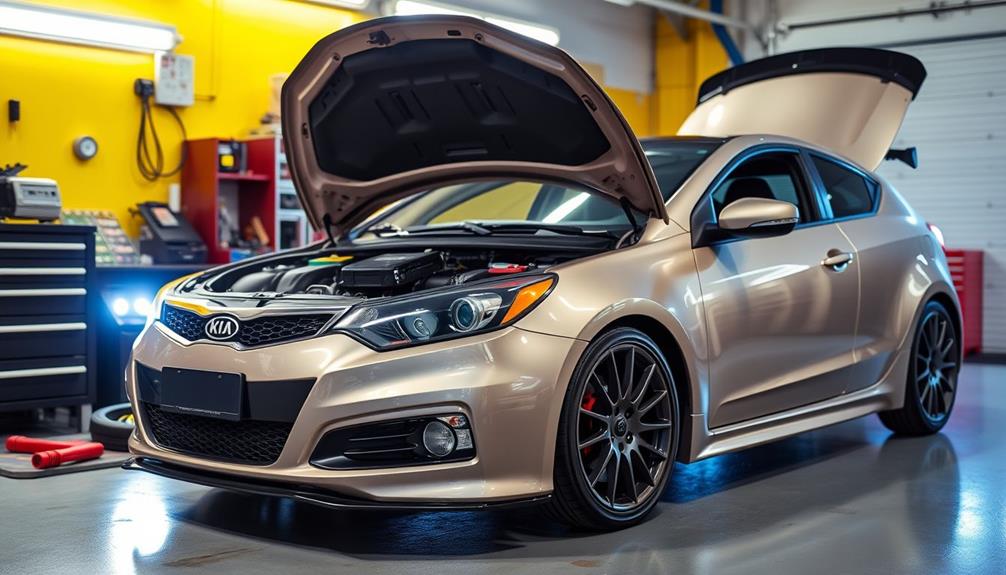
When you tune your Kia Forte's ECU, you can expect notable performance gains, like an increase of around 40 WHP.
Understanding the installation process is key to achieving these enhancements safely and effectively.
Let's explore how to optimize your ride while ensuring reliability.
Performance Gains Explained
Tuning your 2010 Kia Forte's ECU can release impressive gains in horsepower and overall performance. With a Stage 1 tune, you could see an increase of around 40 WHP, bringing your total to approximately 250 HP at the crank.
When you combine this with basic modifications like a Cold Air Intake (CAI) or Short Ram Intake (SRI), you can gain an additional 5-10 horsepower each, further enhancing your driving experience.
Proper ECU tuning doesn't just maximize power output; it also optimizes drivability, often leading to improved fuel economy. You'll notice enhanced throttle response and acceleration, making your Forte feel more engaging and responsive to your inputs.
This responsiveness makes every drive more enjoyable and exciting.
To achieve these performance gains, remember that a retune of the ECU may be necessary after making modifications. This step guarantees that air-fuel ratios and boost levels are correctly managed, allowing you to fully enjoy the benefits of your upgrades.
Installation Process Overview
Upgrading your 2010 Kia Forte's performance through ECU tuning involves a straightforward installation process that can be tackled by most enthusiasts.
To start, you'll need to unplug the battery to guarantee safety while working on your vehicle. Next, locate and replace the ECU unit, which typically requires only basic tools. Numerous online tutorials can guide you through this step to make it even easier.
Once the new ECU is in place, reconnect the battery, and you're almost done. For those looking to enhance engine performance further, consider adding basic modifications like a Cold Air Intake (CAI) or Short Ram Intake (SRI). These enhancements can provide an additional 5-10 horsepower, complementing the gains from your ECU tuning.
After installation, it's vital to monitor your air-fuel ratios and boost levels to prevent engine damage and guarantee peak performance.
If you ever need to revert to the stock ECU, you can easily do so before visiting a dealer, protecting your vehicle's warranty.
With this simple installation process, you'll be well on your way to enjoying a more powerful and efficient Kia Forte.
Installation and Technical Aspects

Installing performance enhancements on your 2010 Kia Forte involves several key steps to secure a smooth process. First, you'll want to disconnect the battery to guarantee safety during the installation.
Next, you may need to remove the stock ECU or intake systems, depending on the modifications you're undertaking. Following detailed guides or videos can help you navigate this process effectively.
Basic modifications, like intake and exhaust upgrades, are typically user-friendly and can be completed without extensive mechanical knowledge—many parts are designed for plug-and-play installation.
However, if you're diving into advanced tuning methods, such as ECU remapping or performance chips, you'll need some technical skills, including computer assembly.
After completing full bolt-on modifications, it's essential to perform a re-tune. This step optimizes the air-fuel ratio and prevents power loss, securing compatibility with your stock ECU.
Utilizing OBD-II technology during the installation allows you to monitor engine performance post-modifications, giving you insights into how well your tuning efforts are paying off.
Risks and Warranty Issues
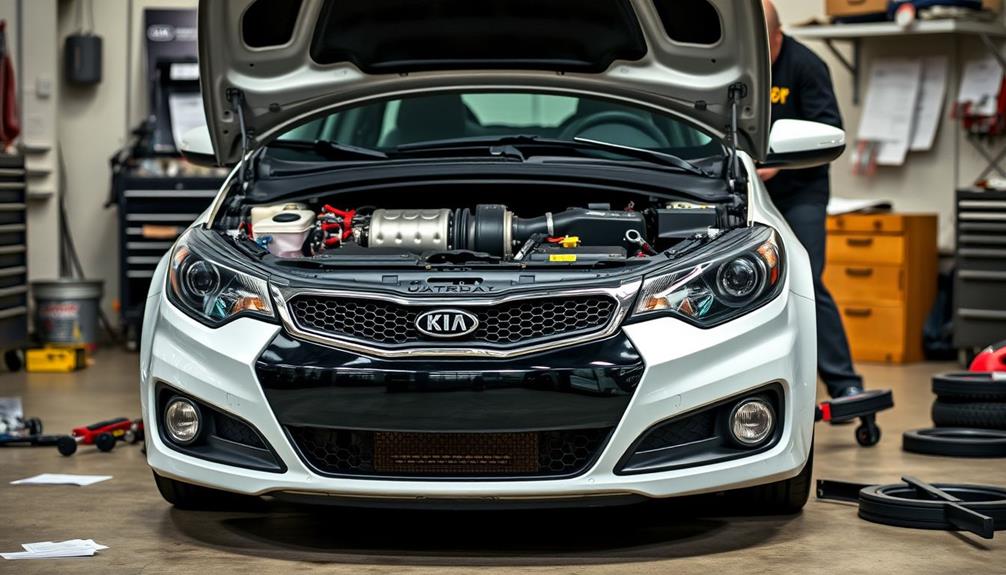
Modifying your 2010 Kia Forte can come with significant risks, particularly regarding warranty coverage. If your modifications lead to engine damage or are detected by the dealer, you could void the manufacturer's warranty. This could mean expensive repairs down the line, leaving you to cover the costs.
If you're leasing your Forte, things get even trickier. Modifications might violate your lease agreement, potentially resulting in additional fees when you return the vehicle.
Furthermore, dealers have the ability to detect aftermarket modifications, even if you revert to the stock ECU before a service visit. It's vital to reinstall the original unit to avoid warranty issues.
Improper tuning can also lead to serious problems, such as engine or turbocharger damage. To mitigate these risks, always use reputable tuning services and guarantee compatibility with your vehicle's components.
Don't forget that ongoing monitoring of your vehicle's performance is essential after tuning. Keeping an eye on your Forte post-modification will help you catch any issues early and guarantee reliability.
Ultimately, weigh the potential benefits against the risks of modifications to make an informed decision about tuning your Kia Forte.
Performance Chip Options

Performance chips are one of the most popular tuning options for enhancing your 2010 Kia Forte's capabilities. These chips can greatly boost engine performance and even improve fuel economy, making them an attractive upgrade for any driver. Here are some options to evaluate:
| Performance Chip | Price | Key Features |
|---|---|---|
| Stage 1 Performance | $99.99 | 100% plug-n-play installation, engine enhancement |
| Stage 3 Performance | $239.95 | Upgraded multi-core CPU, gains in horsepower and torque |
| Stage 4 Performance | $299.95 | LCD monitor for real-time data, advanced tuning |
Installing a performance chip can improve your Forte's fuel economy by up to 4 mpg, making it a cost-effective choice. With all performance chips backed by a money-back guarantee, you can feel confident in your investment. Whether you want a simple upgrade or a more advanced option, there's a performance chip to fit your needs. By selecting the right chip, you'll enjoy increased power and efficiency on every drive.
Fuel Efficiency Improvements
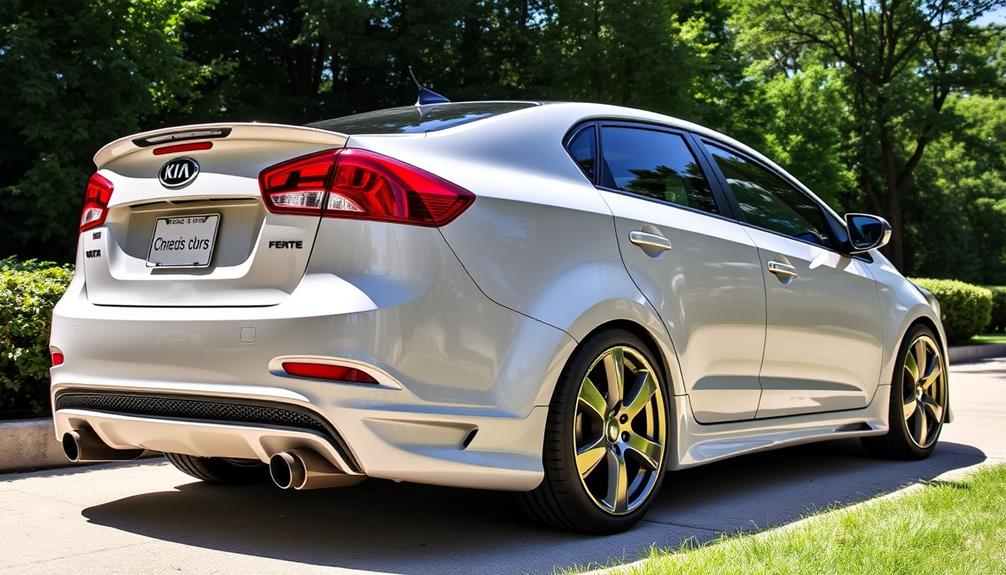
When it comes to enhancing fuel efficiency in your 2010 Kia Forte, tuning options can make a significant difference. By utilizing advanced ECU remapping, you can achieve up to 15% fuel savings without sacrificing performance. This process maximizes engine parameters, ensuring that fuel is used efficiently.
Installing performance chips is another effective way to improve fuel economy. These chips adjust the air-fuel ratios and enhance engine responsiveness, potentially saving you up to 4 mpg.
Additionally, upgrading to a cold air intake or short ram intake system not only boosts horsepower but also improves airflow, contributing to better fuel efficiency.
Proper tuning is essential—making adjustments to the ECU helps eliminate vacuum leaks that can lead to a lean air-fuel mixture, ensuring ideal combustion.
To maintain these fuel efficiency gains, regular maintenance and checks on your modified parts are essential. Ensuring the correct functioning of performance chips and other components will help sustain improved fuel efficiency and overall vehicle performance over time.
Frequently Asked Questions
How Much Horsepower Can You Get Out of a Kia Forte Gt?
You can get up to 201 horsepower from the Kia Forte GT with basic modifications. Advanced tuning might push it closer to 250 horsepower, especially when using E85 fuel for peak performance gains.
What Does Eco Mode Do on Kia Forte?
Eco Mode optimizes your Kia Forte's engine performance by adjusting throttle response and transmission shifting, enhancing fuel efficiency. It can improve fuel economy by up to 15%, ensuring comfort while minimizing energy use.
How Many Miles Will a 2010 Kia Forte Last?
If you maintain your 2010 Kia Forte like it's a prized racehorse, you could see it galloping past 250,000 miles! With diligent care, it'll likely outlast your wildest road trip dreams. Keep it happy!
What Are the Most Common Problems With a 2010 Kia Forte?
You might encounter rough transmission shifts, excessive oil consumption, and electrical issues with power windows and locks in a 2010 Kia Forte. Suspension wear and rust can also affect your vehicle's performance and longevity.
Conclusion
In your quest to transform your 2010 Kia Forte into a powerhouse, you've got the tools and knowledge to ignite its potential. With the right upgrades, you can release a symphony of performance that dances on the road while sipping fuel wisely. Embrace the thrill of tuning, but tread carefully through the twists of warranty and risks. Your compact sedan can roar like a lion or glide like a gazelle—it's all in your hands. Let the journey begin!
